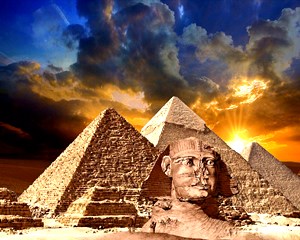The Pyramids stand at the edge of the desert, on the western side of the Nile, but an hour or two's distance from the city. After crossing the ferry, the stranger imagines them close at hand, though he has still a good long mile to traverse. A near view is generally disappointing; and it is not until the visitor begins to make comparisons, that the fact of their exceeding vastness comes home to the mind. The base of the Great Pyramid of Cheops is nearly 800 feet square, covering a surface of eleven acres; and its height is 461 feet, being 117 feet higher than St. Paul's Cathedral. It is a common feat of travellers to ascend, with the aid of a couple of Arab guides, to the summit; which may be reached by an active man in about twenty minutes.

"The view from the top," says Stanley, "has the same vivid contrast of life and death which makes all wide views in Egypt striking—the desert and the green plain: only the view over the desert—the African desert—being much more extensive here than elsewhere, one gathers in better the notion of the wide, heaving ocean of sandy billows, which hovers on the edge of the Valley of the Nile. The white line of the minarets of Cairois also a peculiar feature—peculiar, because it is strange to see a modern Egyptian city which is a grace instead of a deformity to the view. You see also the strip of desert running into the green plain on the east of the Nile, which marks Heliop'olis and Goshen."












